UEA
ENV
CRU
Homepage
Data
CRU links
CRU staff
CRU data
Keith Briffa
External links
InterpretingCC
Norwich weather
Foulsham
Homepage
NAO
The "Schweingruber tree-ring data set"
During the 1980s and 1990s, Fritz Schweingruber (Swiss Federal Institute of Forest, Snow and Landscape Research, Birmensdorf), together with a number of colleagues, collected tree-core samples from hundreds of sites across the Northern Hemisphere, which were processed and measured to obtain a range of tree-growth parameters, including total ring width (TRW) and maximum latewood density (MXD).
Because much of the data collection and processing was carried out by, or under the direction of, Fritz Schweingruber the data set is sometimes called the "Schweingruber network of tree-ring data". These data are available from the WSL-Birmensdorf Tree Ring Data 2000 page at the International Tree-Ring Data Bank (ITRDB), part of the World Data Center for Paleoclimatology, hosted by the US National Climatic Data Center.
Various subsets of this data set have been used in a number of studies published by Keith Briffa, Tim Osborn and other colleagues at the Climatic Research Unit (see below for references). In particular, the focus of our work has been mostly on data measured from tree-core samples that were collected at relatively cool and moist sites. These sites are generally at high elevation or high latitude, covering much of the Northern Hemisphere between 20 and 75°N.
This webpage provides further details about the particular subsets of data used
in some of these studies.
Briffa et al. (1998a, Nature)
full reference
Reduced sensitivity of recent tree-growth to temperature at high northern latitudes
- Tree-ring data selection
- At the time that this study was undertaken, data were available from 331 sites in the Schweingruber TRW/MXD network.
- Out of these 331 sites, 17 were excluded on the basis that their location in more arid parts of southern Europe or central Asia might limit their usefulness as proxies for summer temperature variability. Later, more detailed analysis reported in Briffa et al. (2002a) indicated that tree growth at some of these excluded sites does contain a signal of summer temperature, but that it is a relatively weak signal in most cases (especially for TRW).
- After exclusion of these 17 sites, data from 314 sites remained.
- Tree-ring data locations
- TRW and MXD from tree-cores sampled at 314 sites were used, assembled into 314 site chronologies, and then averaged into 8 regions (plus 3 composite regions). Numbers of sites in each region are given in the caption to Figure 1 of the original paper.
- The locations of the 314 site chronologies are provided in a Table here.
- The tree-core measurement data themselves are available from the International Tree-Ring Data Bank, using the information provided in this Table to identify the sites that we used.
- This map shows the locations of the 314 site chronologies:
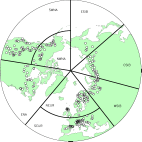
Click here, or on the map, for a larger image.
- Standardisation
- The TRW and MXD measurement series from individual tree cores were "standardised" to reduce age-related bias by expressing them as dimensionless residuals from a generalized exponential (or "Hugershoff") function that was fit to the raw data, as described in the original paper. The 314 site chronologies were then assembled from averages of these standardised series.
- This Hugershoff standardisation results in the loss of variance on long time scales that might be caused by changing climate, and the 314 site chronologies used in this study are, therefore, suited for investigation of climate variability only on time scales up to a century.
Briffa et al. (1998b, Nature)
full reference
Influence of volcanic eruptions on Northern Hemisphere summer temperature over the past 600 years
- Tree-ring data selection
- At the time that this study was undertaken, the number of relatively cool and moist sites for which MXD measurements were available had grown to 391. The additional data came mostly from an expansion of the network into eastern Siberia, and from additional sites near to the Tibetan Plateau.
- Out of these 391 sites, all those at latitudes polewards of 30N were selected for use. The 9 sites south of 30N in the Tibetan Plateau area were not used, because the focus of the study was on the mid to high latitudes of the Northern Hemisphere.
- After exclusion of these 9 sites, data from 382 sites remained.
- Measurements from one of these sites were unintentionally included twice, building two almost identical site chronologies, and resulting in a list of 383 sites. The chronology that was inadvertently duplicated was "Baikalsee, Irkutsk", which appears twice in the location table (see next section). This unintentional duplication has only a negligible affect on the results, because this chronology only has data for the short period 1890-1978, when almost all of the other 381 sites have data.
- Tree-ring data locations
- MXD from tree-cores sampled at 383 sites were used, assembled into 383 site chronologies, then averaged into 5 regions, and then into a single series representing the Northern Hemisphere.
- The locations of the 383 site chronologies are provided in a Table here (note that one site appears twice, because it was mistakenly duplicated; see previous section).
- The tree-core measurement data themselves are available from the International Tree-Ring Data Bank, using the information provided in this Table to identify the sites that we used.
- This map shows the locations of the 383 site chronologies:
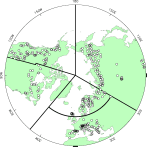
Click here, or on the map, for a larger image.
- Standardisation
- The MXD measurement series from individual tree cores were "standardised" to reduce age-related bias by expressing them as dimensionless residuals from a generalized exponential (or "Hugershoff") function that was fit to the raw data, as described in the original paper. The 383 site chronologies were then assembled from averages of these standardised series.
- This Hugershoff standardisation results in the loss of variance on long time scales that might be caused by changing climate, and the 383 site chronologies used in this study are, therefore, suited for investigation of climate variability only on time scales up to a century.
Briffa et al. (2002a, The Holocene)
full reference
Tree-ring width and density data around the Northern Hemisphere: part 1, local and regional climate signals
- Tree-ring data selection
- At the time that this study was undertaken, the number of relatively cool and moist sites for which TRW and MXD measurements were available had increased by 2 more sites (in western USA) to 393.
- No sites were excluded on the basis of location, because the purpose of this paper was to investigate the geographical variation in the climate sensitivity of the tree-ring data across the entire network.
- Data from 7 sites which did not have measurements from trees growing in the 20th century were excluded, because 20th century data were necessary for comparison with temperature and precipitation observations.
- After exclusion of these 7 sites, data from 386 sites remained.
- As in Briffa et al. (1998b) (see above for more information), data from one of the sites were unintentionally duplicated, so that we actually used 387 sites. The duplicated site has negligible influence on the results of this study.
- Most of the analyses presented in this study were based on this set of 387 sites.
- The regional-mean time series shown in Figures 11 and 12 of the original paper (and for which correlations with climate data were shown in other figures) were, however, calculated following the exclusion of chronologies that exhibited poor correlation with instrumental temperatures.
- For the MXD data, 46 site chronologies that exhibited r < 0.22 with local grid-box April-September temperatures were excluded. The remaining 341 site chronologies were used to create the MXD regional averages.
- For the TRW data, 260 site chronologies that exhibited r < 0.22 with local grid-box June-August temperatures were excluded. The remaining 127 site chronologies were used to create the TRW regional averages.
- Tree-ring data locations
- TRW and MXD from tree-cores sampled at 387 sites were used, assembled into 387 site chronologies, to assess the range of climate signals present in the data set.
- The locations of the 387 site chronologies are provided in a Table here (note that one site appears twice, because it was mistakenly duplicated; see previous section).
- MXD from tree-cores sampled at 341 sites were used, assembled into 341 site chronologies, to generate regional and hemispheric average MXD time series.
- The locations of the 341 site chronologies are provided in a Table here (note that one site appears twice, because it was mistakenly duplicated; see previous section).
- TRW from tree-cores sampled at 127 sites were used, assembled into 127 site chronologies, to generate regional and hemispheric average TRW time series.
- The locations of the 127 site chronologies are provided in a Table here.
- The tree-core measurement data themselves are available from the International Tree-Ring Data Bank, using the information provided in these Tables to identify the sites that we used.
- These maps show the locations of the 387, 341 and 127 site chronologies:
All 387 sites
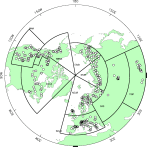
Click here, or on the map, for a larger image.341 MXD sites
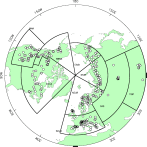
Click here, or on the map, for a larger image.127 TRW sites
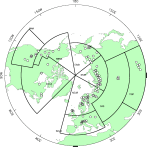
Click here, or on the map, for a larger image.
- Standardisation
- The TRW and MXD measurement series from individual tree cores were "standardised" to reduce age-related bias by expressing them as dimensionless residuals from a generalized exponential (or "Hugershoff") function that was fit to the raw data, as described in the original paper. The site chronologies were then assembled from averages of these standardised series.
- This Hugershoff standardisation results in the loss of variance on long time scales that might be caused by changing climate, and the site chronologies used in this study are, therefore, suited for investigation of climate variability only on time scales up to a century.
Briffa et al. (2001, Journal of Geophysical Research)
full reference
Low-frequency temperature variations from a northern tree-ring-density network
- Tree-ring data selection
- MXD measurements from individual tree cores (i.e., prior to averaging them into mean chronologies for each site) were provided by Fritz Schweingruber for 389 sites.
- No sites were excluded; all 389 sites were used. The paper mistakenly states (in the caption of Figure 1) that 387 sites were used.
- Of the 389 sites that were used for this study, most were also used in the Briffa et al. (2002a) study described above. Only a handful of sites differ between the two studies.
- Tree-ring data locations
- MXD from tree-cores sampled at 389 sites were used for this analysis.
- The locations of the 389 sites are provided in a Table here.
- The tree-core measurement data themselves are available from the International Tree-Ring Data Bank, using the information provided in these Tables to identify the sites that we used.
- This map shows the locations of the 389 tree-ring sites:
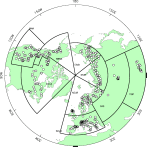
Click here, or on the map, for a larger image.
- Standardisation
- The MXD measurement series from individual tree cores were processed using the Age-Band Decomposition method introduced and described in this paper. The rationale for this new method is that if data are initially analysed and combined within relatively narrow ranges of tree age, then it is no longer necessary to detrend individual tree-core time series to remove any dependence on tree age. This detrending, which is part of traditional standardisation techniques, results in the loss of variance on long time scales that might be caused by changing climate. Because the Age-Band Decomposition method does not require this detrending step, the reconstructions obtained with it have stronger variance on longer time scales. The method may introduce different types of uncertainty compared with traditional standardisation methods, especially when the sample of tree-ring measurements is small, so we consider that the regional and hemispheric reconstructions produced using this method are more appropriate for the study of climate variations on multi-decadal time scales and longer.
Rutherford et al. (2005, Journal of Climate)
full reference
Proxy-based Northern Hemisphere surface temperature reconstructions: sensitivity to
method, predictor network, target season and target domain
- Tree-ring data selection
- The MXD data from the 341 sites determined by Briffa et al. (2002a) to exhibit correlations with nearby gridded April-September temperature of at least +0.22 were used in this study. See Briffa et al. (2002a) and the data description above for further details.
- Tree-ring data locations
- MXD from tree-cores sampled at 341 sites were used, assembled into 341 site chronologies.
- The locations of the 341 site chronologies are provided in a Table here (note that one site appears twice, because it was mistakenly duplicated; see earlier section).
- The tree-core measurement data themselves are available from the International Tree-Ring Data Bank, using the information provided in these Tables to identify the sites that we used.
- This map shows the locations of the 341 site chronologies:

Click here, or on the map, for a larger image.
- Processing and Standardisation
- The MXD chronologies that had been "standardised" by expressing them as dimensionless residuals from a generalized exponential (or "Hugershoff") function that was fit to the raw data were used (see further description above). These 341 chronologies were gridded into a regular grid, with resolution of 5 degrees of latitude and longitude.
- As described above, the standardisation results in a loss of variance on long time scales. We compared the regional averages of this standardised data with the regional averages presented by Briffa et al. (2001) based on the Age-Band Decomposition method, that was designed to avoid the loss of variance on long time scales. The difference between these series indicates, on the regional scale, the variance that is lost during the standardisation. We added to each grid box series the "missing" regional-scale low-frequency information identified in this way.
- The resulting gridded data combine the spatial resolution allowed by using site chronologies with the low-frequency information obtained by the regional-scale Age-Band Decomposition analysis.
- Gridded data
- The gridded MXD data, with the subsequent adjustment of their multi-decadal and longer variations to match (at regional scales) the regional reconstructions of Briffa et al. (2001), are available here.
- The (text or ASCII format file) has 115 columns and 595 rows. Each column represents one grid-box time series, while each row represents one year, starting in 1400 and ending in 1994. The latitude and longitude at the centre of each grid box are given in the separate locations file.
- The values after 1960 show the "divergence" from instrumental temperatures that has been discussed previously by, for example, Briffa et al. (1998a, 2001, 2002a, 2004). In developing large-scale reconstructions from these data (e.g., Briffa et al., 2001; Rutherford et al., 2005), we have chosen to exclude any values after 1960 because of uncertainty about the cause of this divergence.
- Locations file
- Gridded data file (units are arbitrary)
References
- Osborn TJ, Briffa KR and Jones PD (1997)
Adjusting variance for sample-size in tree-ring chronologies and other regional-mean timeseries.
Dendrochronologia 15, 89-99.
- Briffa KR, Schweingruber FH, Jones PD,
Osborn TJ, Shiyatov SG and
Vaganov EA (1998a) Reduced sensitivity of recent tree growth to temperature at
high northern latitudes. Nature 391, 678-682.
- Briffa KR, Jones PD, Schweingruber FH and
Osborn TJ (1998b) Influence of volcanic eruptions
on Northern Hemisphere summer temperature over the past 600 years.
Nature 393, 450-455.
- Briffa KR, Schweingruber FH, Jones PD,
Osborn TJ, Harris IC, Shiyatov SG
and Vaganov EA (1998c) Trees tell of past climates: but are they speaking less
clearly today? Philosophical Transactions of the Royal Society
353, 65-73.
- Briffa KR and Osborn TJ
(1999) Seeing the wood from the trees. Science 284,
926-927.
- Osborn TJ and Briffa KR (2000)
Revisiting timescale-dependent reconstruction of climate from tree-ring chronologies.
Dendrochronologia 18, 9-26.
- Briffa KR, Osborn TJ, Schweingruber FH,
Harris IC, Jones PD, Shiyatov SG and Vaganov EA (2001)
Low-frequency temperature variations
from a northern tree-ring-density network.
Journal of Geophysical Research 106, 2929-2941.
- Briffa KR, Osborn TJ, Schweingruber FH,
Jones PD, Shiyatov SG and Vaganov EA (2002a) Tree-ring width and density
data around the Northern Hemisphere: part 1, local and regional
climate signals.
The Holocene 12, 737-757.
- Briffa KR, Osborn TJ, Schweingruber FH,
Jones PD, Shiyatov SG and Vaganov EA (2002b) Tree-ring width and density
data around the Northern Hemisphere: part 2, spatio-temporal
variability and associated climate patterns.
The Holocene 12, 759-789.
- Briffa KR, Osborn TJ and Schweingruber FH (2004)
Large-scale temperature inferences from tree rings: a review.
Global and planetary change 40, 11-26.
- Rutherford SD, Mann ME, Osborn TJ, Bradley RS, Briffa KR, Hughes MK and Jones PD (2005) Proxy-based Northern Hemisphere surface temperature reconstructions: sensitivity to method, predictor network, target season and target domain. Journal of Climate 18, 2308-2329.